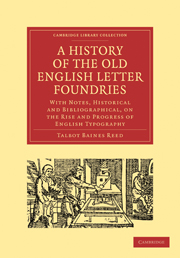 A History of the Old English Letter Foundries
A History of the Old English Letter Foundries Published online by Cambridge University Press: 05 August 2011
In taking a brief survey of that early period of English Typography when printers are assumed to have been their own letter-founders, we shall attempt no more than to gather together, as concisely as possible, any facts which may throw light on the first days of English letter founding, leaving it to the historian of Printing to describe the productions which, as we have already stated, must be regarded, not only as the works of our earliest printers, but as the specimen-books of our earliest letter-founders. Mores and other chroniclers are, as we conceive, misleading, when they single out half a dozen names from the long list of printers between Caxton and Day, as if they only had been concerned in the development of the art of letter-cutting and founding. It is true that these names are the most distinguished; but it is necessary to bear in mind that the most obscure printer of that day, unless he succeeded in purchasing his founts from abroad, or in obtaining the reversion of the worn types of another printer, probably cast his letter in his own moulds, and from his own matrices.
Respecting many of our early printers, our information especially with regard to their mechanical operations, is extremely meagre. But the researches of Mr. William Blades have thrown a stream of light upon the typography of Caxton and his contemporaries, of which we gladly avail ourselves in recording the following facts and conjectures as to the letter-founding of the period in which they flourished.
To save this book to your Kindle, first ensure [email protected] is added to your Approved Personal Document E-mail List under your Personal Document Settings on the Manage Your Content and Devices page of your Amazon account. Then enter the ‘name’ part of your Kindle email address below. Find out more about saving to your Kindle.
Note you can select to save to either the @free.kindle.com or @kindle.com variations. ‘@free.kindle.com’ emails are free but can only be saved to your device when it is connected to wi-fi. ‘@kindle.com’ emails can be delivered even when you are not connected to wi-fi, but note that service fees apply.
Find out more about the Kindle Personal Document Service.
To save content items to your account, please confirm that you agree to abide by our usage policies. If this is the first time you use this feature, you will be asked to authorise Cambridge Core to connect with your account. Find out more about saving content to Dropbox.
To save content items to your account, please confirm that you agree to abide by our usage policies. If this is the first time you use this feature, you will be asked to authorise Cambridge Core to connect with your account. Find out more about saving content to Google Drive.